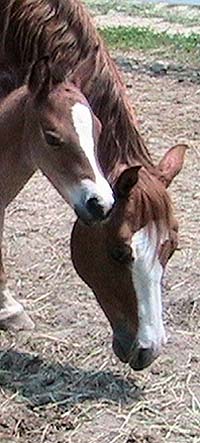|
Starting two year olds is actually my favorite part of the whole gig. I rarely keep one past their third birthday. Because
I'm a nonpro, I can do it a little differently than a professional trainer would...
I usually get my yearlings up during the late summer of their yearling year. All I do is tie them and groom them, then leave
them tied while I'm riding the two year old.
As soon as I can, I start saddling them and just letting them soak in the saddle while I'm riding the two year old. Couple
weeks of that and I can start putting a little weight in a stirrup. That increases gradually until I can swing a leg over,
usually about midfall. Very, very slow program.
For a couple of weeks, I'll get up there and just sit. 'Bout winter, we get in a small pen and have a first ride. First
ride rarely lasts more than 3 minutes. With just a halter and lead rope on, I pull them around and get a few steps to the
left and a few steps to the right, then get off. Each day progressively increases, but very, very slowly. Takes a long time
before I am riding them for more than 10 or 15 minutes at a time. Takes a little while before I am actually riding them for
that long. I rarely ever have one give me any trouble this way.
Novelty is often what is frightening for the twos, and there is usually not much of anything novel in this program. All of
the introductions to new things in my program are done so slowly and incrementally that the biggest shock to the colt is the
day he is saddled. Everything else is pretty much just building a tiny little bit on what we did the day and week before.
If he never gets scared, he usually doesn't give me any trouble.
--Jared Melton
We follow a similar program to Jared's. Right now (end of October), the yearlings have all been tied, groomed, clipped and
taught ground work in the round pen.
They've felt the weight of a saddle on them, and one of them has actually been round penned under saddle. I've had my weight
on them (bareback, lying across their backs while someone holds their heads and if they don't object, leads them a few steps)
and this will continue probably until next month or so.
By the end of December, all 3 of them will have had a rider in the saddle for a few minutes at a time, and they'll be ready
for their training to start by the end of January, beginning of February.
--Joy Frannicola
I similar to Jared except before I get on them, I ground drive them. First in the round pen, then all over the property.
BARBARA HARTWIG
SOUTHERNHART RANCH
http://www.southernhartranch.com/
Since I ride and work alone with the horses most of the time, I have to be very careful about never scaring them. So I start
really early.
It begins when they are weaned. I may do things differently than most folks, I dont handle my foals until I am ready
to wean. I put the mare and foal in adjoining stalls, and when I can safely get a halter on the foal without it being a big
fuss, I leave the halter and a long lead rope on them. This is done in a stall that is as safe as I can get it, no protruding
object for a halter to get hung on. With this method, the foals halter break themselves.
Then I gradually start tying them up, rubbing them, hobble breaking, and it goes on like that doing different stuff with
them until they are comfortable with me.
Over the next 2 years, I teach them to lunge in the round pen, saddle them, drive them under saddle, do anything at all
I can to get them used to things they will have to put up with later in life. As soon as I feel the horse is not going to
become goofy,(and that's the key part with me, if I think they're going to be stupid, I take as long as I need), I will start
putting my foot in a stirrup, then putting weight on a stirrup, then raising up over the horse, lean over them get them used
to seeing me on both sides. Then when I am ready to sit on the horse, I usually have someone hold them, then lead me around
just letting the horse get used to carrying weight, moving my arms around, legs, touching them.
Basically, if you've taught the horse they have nothing to fear from
you, everything from here on out, is pretty easy. Oh, I also pony them on trail rides, take them to local shows, ropings,
cuttings, barrel races, whatever I can find to expose them to all kinds of stuff. I'll take them and if nothing else I'll
tie them up somewhere, or at the trailer, and let them stand. Lots of standing tied at home also, that's a good patience builder
for a colt.
As a matter of fact, when I took my 4yo, who I didnt start until she was 3 because she got hurt, to a local show, she
was the better behaved of the two I brought, one of which is my older gelding that I show. Thats basically how I do it, and
Im sure I am making mistakes along the way, that someone more experienced can point out. Which btw, I would appreciate..
:)
--Lisa P.
|
